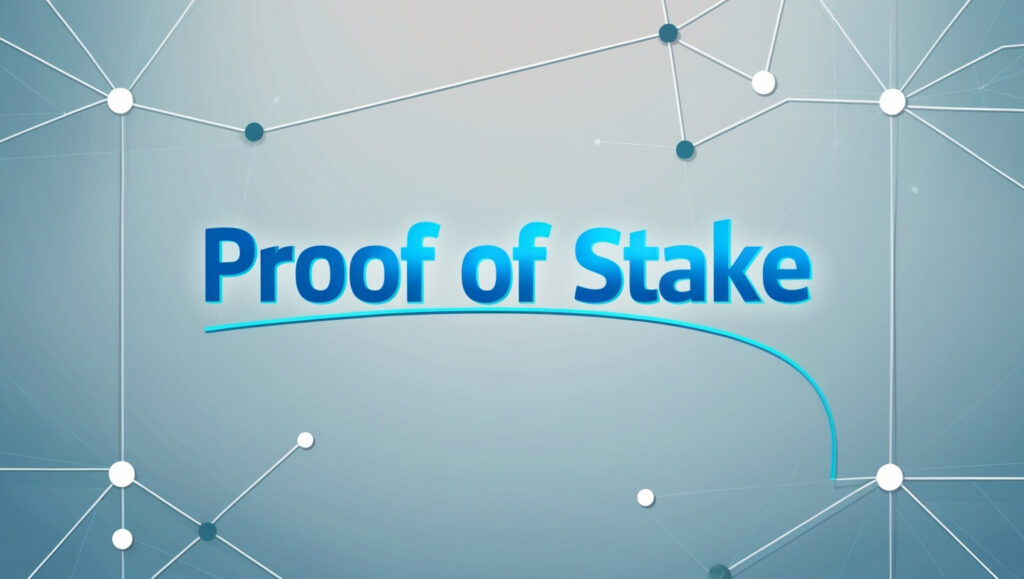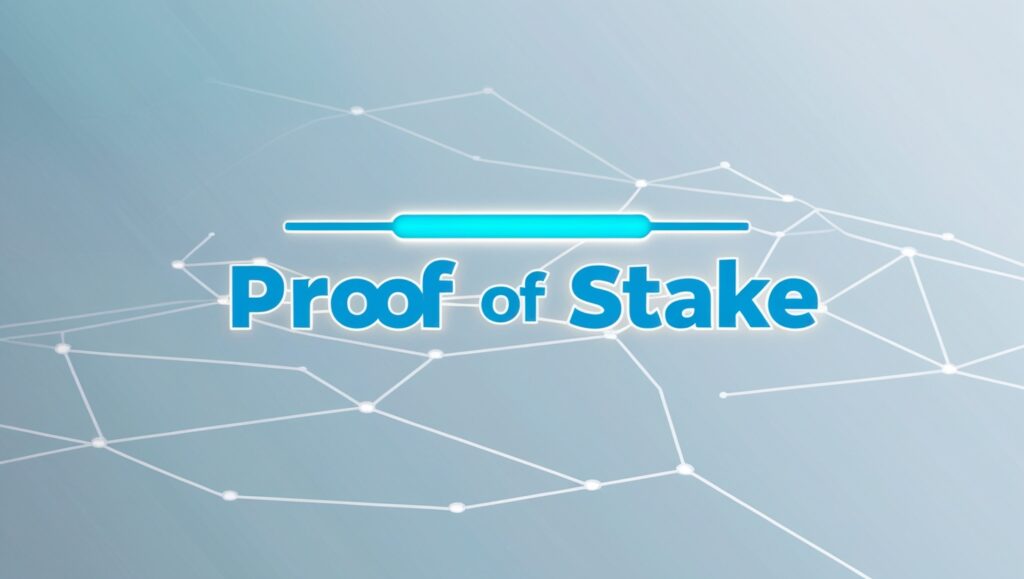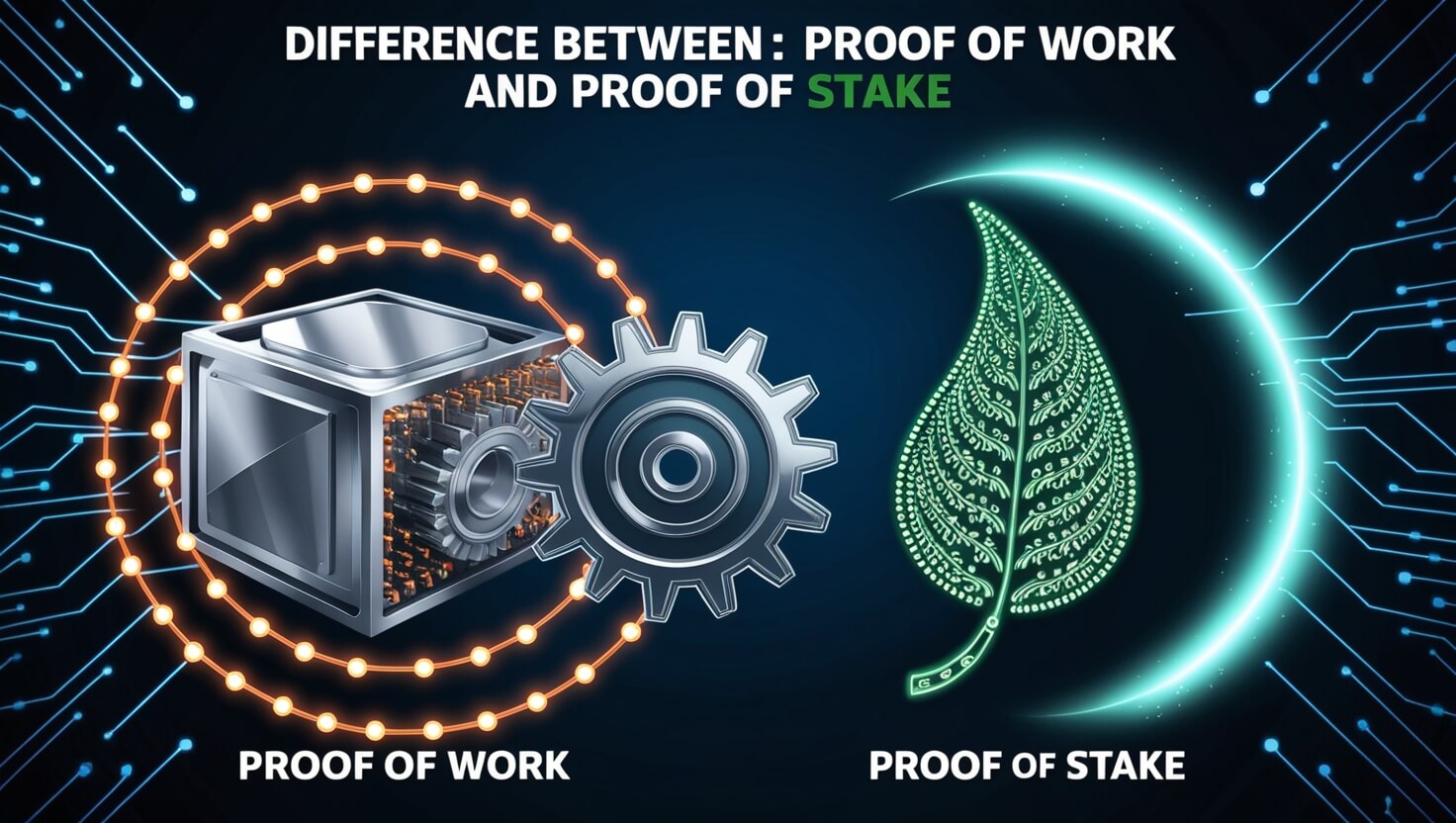This article will explain Difference Between Proof Of Work And Proof Of Stake, the two most popular consensus mechanisms within the blockchain ecosystem.
In PoW, miners validate transactions by solving intricate puzzles, while in PoS, validators are selected depending on their stake within the network.
Knowing the differences is essential for assessing scalability, security, and energy consumption within a blockchain.
What is Proof Of Work?
Proof of Work (PoW) serves as a consensus method for blockchain networks to authenticate transactions and safeguard the network.
It depends on users known as miners who use significant computational power to solve challenging mathematical puzzles.

The one who solves the puzzle first gets to append a new block to the blockchain and subsequently receives cryptocurrency in return.
PoW is known to strengthen network security by making attacks expensive and illogical; an attacker attempting to alter the blockchain would need enormous computing power.
Before switching to Proof of Stake, Bitcoin and Ethereum were famous examples of cryptocurrencies which utilized PoW.
What is Proof Of Stake?
Proof of Stake (PoS) is a blockchain consensus mechanisms picks validators by the number of coins they stake.
Unlike Proof of Work (PoW), PoS reduces energy consumption by demoliting the need for intensive mining.

Under PoS, validators set aside a predetermined quantity of cryptocurrency as collateral and the network picks at random those who are eligible to confirm transactions.
The more coins staked, the higher the chances of being chosen making it even more secure. Major blockchains who stake to PoS are Ethereum, Solana and Cardano.
Difference Between Proof Of Work And Proof Of Stake
| Proof of Work (PoW) | Proof of Stake (PoS) |
|---|---|
| Probability of mining a block depends on computational work done by miners. | Probability of validating a block depends on the number of coins staked. |
| First miner to solve the cryptographic puzzle gets a block reward. | Validators do not receive block rewards but collect network transaction fees. |
| Miners compete by solving complex puzzles using computational power. | No competition; block creator is chosen by an algorithm based on stake. |
| Attackers need 51% of the total computational power to manipulate the blockchain. | Attackers need 51% of all cryptocurrency on the network, which is highly impractical. |
| Less energy efficient, requiring high computational power. | More energy and cost-efficient compared to PoW. |
| Specialized hardware (ASICs, GPUs) is needed for optimal mining. | Standard server-grade units are sufficient for validation. |
| Requires buying expensive hardware to participate in mining. | Requires buying and staking cryptocurrency to become a validator. |
| Bitcoin (BTC) uses PoW with SHA-256 hashing. | Cryptocurrencies like Cardano (ADA), Tezos (XTZ), EOS, and Cosmos (ATOM) use PoS. |
How Proof of Work Functions

Collection of transaction: A miner grabs any available transactions from the network and adds them to a candidate block.
Solving the Puzzle: Miners work against each other to complete a mathematical puzzle which consists of discovering a nonce (random number) which hashed together with the blocks’ data fits the desired hash produced by the network’s difficulty level.
Verification of block: The first miner who successfully solves the puzzle, advertises the new block to the network. Other miners are now able to validate the proposed solution to the puzzle and the transactions included in the block.
Addition of block: When all validators mark this block as verified, the system incorporates the block in the blockchain, while the miner that proposed this block is rewarded with a block and transaction fee in cryptocurrency.
How PoS Works

Staking: Validators put a certain amount of cryptocurrency on hold as their stake in the network. This amount serves as collateral, thus motivating to the stakeholders to safeguard the network.
Block Proposing: The system uses a random approach to select validators for proposing new blocks depending on the magnitude of their stake and sometimes other things like the age of the stake or randomization.
Block Validation: Other validators review the block to either correct it or not. A correct block is included into the blockchain.
Rewards and Penalties: Validators earn rewards in the form of transaction fees or newly minted coins during the activities. At the same time, they may face losses, even total loss of all staked coins if they act in maleficent ways.
Advantages & Disadvantages of Proof of Work (PoW)
| Advantages | Disadvantages |
|---|---|
| Highly secure against attacks due to the high cost of acquiring 51% of the network’s computational power. | Vulnerable to 51% attacks if a single entity gains majority hash power. |
| Open to anyone with mining hardware, promoting a decentralized network. | Mining pools lead to centralization, where a few entities control most of the hash rate. |
| Used in Bitcoin and other major cryptocurrencies, making it a well-tested consensus mechanism. | Energy-intensive, requiring significant electricity to operate. |
| Rewards are based on computational effort, ensuring fairness. | Requires specialized mining hardware (ASICs), which creates a barrier to entry. |
| Unlike PoS, where wealthier individuals have more control, PoW relies on computational work rather than coin ownership. | High entry cost due to the need for expensive mining rigs. |
| Works well for securing transactions but struggles with large-scale adoption. | Slow transaction speeds and high fees due to network congestion. |
Advantages & Disadvantages of Proof Of Stake
| Advantages | Disadvantages |
|---|---|
| Requires significantly less electricity compared to PoW, making it environmentally friendly. | Some PoS systems may still require high energy use if poorly designed. |
| No need for expensive mining hardware; a standard server is enough. | Requires users to own a large stake to have significant influence, favoring early adopters. |
| Faster transaction processing and lower fees compared to PoW networks. | Some PoS blockchains are less battle-tested than PoW systems. |
| Attacking the network requires owning 51% of the total stake, which is expensive and impractical. | Wealth centralization—those with more coins have greater control over the network. |
| Eliminates wasteful computational competition, allowing for a more sustainable network. | Nothing at Stake Problem—validators may attempt to support multiple chains, risking security. |
| Validators earn rewards through transaction fees instead of block rewards, reducing inflation. | Validators may act maliciously or collude if governance isn’t properly managed. |
The Future of Blockchain: Will Proof of Stake Come Next?
With the steady development of blockchain technology, it is highly likely that many experts are looking at Proof of Stake (PoS) to become the consensus mechanism for the future.
Ethereum’s migration toward PoS will serve as a catalyst for many other projects looking to adopt this consensus mechanism due to it being more scalable and energy efficient.
There is rising concern over sustainability as well as the need for quick PoS transactions. Therefore, these features are well-matched with the increasing demands for efficient and green solutions.
Although, Proof of Work (PoW) still has a firm grasp in the crypto sphere, primarily with Bitcoin.
The most secure and decentralized network that boasts about having the highest PoW mining difficulty level also relies on it for its solid security model.
Even with the energy consuming PoS becoming more popular, PoW does still have its places as there are networks whose primary focus is on security and immutability.
Which Blockchains Use Proof of Work And Proof of Stake?

PoW Blockchains: Besides Bitcoin, Litecoin and Bitcoin Cash also follow PoW, and are considerably the most known Blockchains that do. These networks are secured by miners validating transactions using extensive computational resources.
PoS Blockchains: Many modern blockchains favor PoS for its efficiency, Ethereum, after transitioning to Ethereum 2.0, is now a leading PoS Network.

Cardano, Solana, and Polkadot are other significant blockchains that are PoS-based and their main focus is on fast growth, operational efficiency, and low energy usage.
Conclusion
Proof of Work (PoW) and Proof of Stake (PoS) contribute significantly towards protecting and reaching consensus in blockchains. PoW has high security features but comes with heavy energy consumption and computer power usage, making it inefficient.
Contrary to this, PoS selects validators based on their stake and offers an eco-friendly, scalable option. While PoW still controls networks like Bitcoin, PoS is being preferred for its sustainability and lesser costs of operation.
With the evolving technology in blockchains, PoS will lead the adoption of in the future, however, PoW will always remain fundamental to providing decentralized security.









